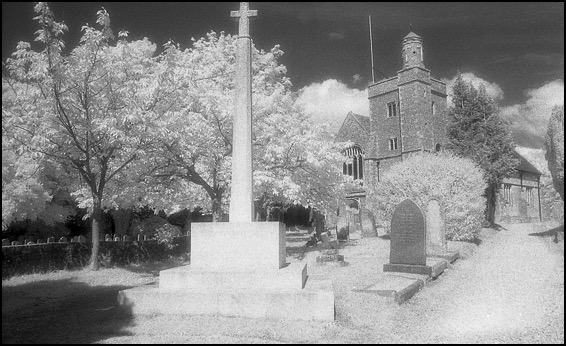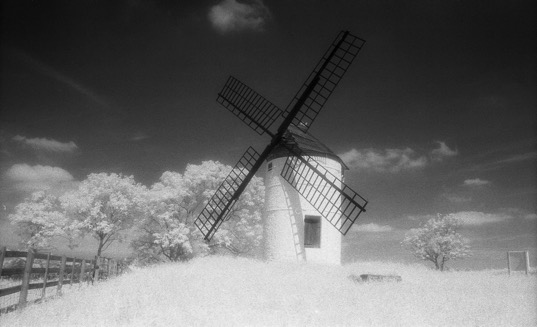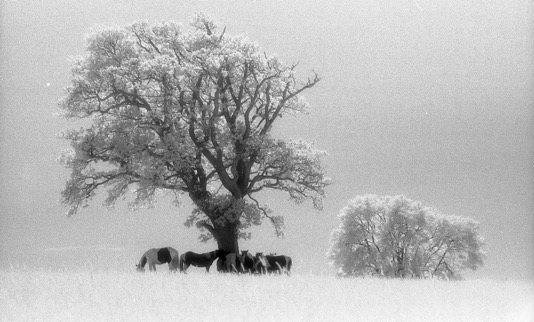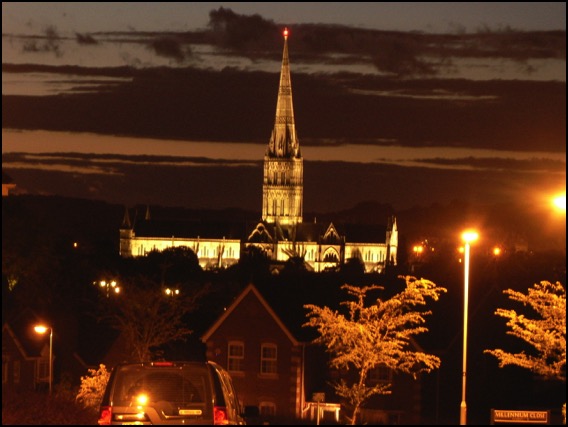Photography
Infra-red landscapes II
Wednesday, 16 March, 2011. Filed under: Photography | Landscapes
Two more infra-red landscapes liberated from the family photo album, as taken by my mum. The lighthouse is on the shoreline of Burnham-on-Sea in Somerset, a little to the north of the town centre. The church, meanwhile, is marked as "Wilton", although a cursory glance around the area (I live in Salisbury, 'next door' to Wilton) hasn't helped me find it. It may be a different Wilton - my mum took infra-red all over the south west.




Comments
Infra-red Landscapes
Tuesday, 23 November, 2010. Filed under: Photography | Landscapes
I’ve been going through the family photos and have come across some negatives from a collection of infra-red pictures taken by my mum a few years ago, including a few landscapes. They are really quite beautiful, rendering the sky dark and anything green as shining bright - lending the pictures an ethereal quality. See what you think.




Landscape appreciation
Thursday, 02 September, 2010. Filed under: Landscapes
In the course of the relentless campaign of internet dredging I like to characterise as “research”, it’s often quite difficult to find sites of interest to the landscape enthusiast, but on the odd occasion I manage to discover a real gem. Two such gems - though related to one another - are the websites of Landscape Appreciation and Landscape Genres. Both sites are off-shoots of a Yahoo Group of landscape appreciators and each has a slightly different focus. Landscape Genres seems dedicated to classifying different kinds of topography according to a slightly psycho-geographical formula while Landscape Appreciation is more wide-ranging and includes a number of fascinating articles on the artistic representation of landscape, the idea of genius loci - the spirit of place - and the history of landscape tourism through the production of postcards, photo-chromes, photos and other tourist artefacts. Recommended.
Night time views - Salisbury
Tuesday, 24 August, 2010. Filed under: Photography | Views & Scenery
Sometimes it’s hard to get the full beauty of a viewpoint amongst all the clutter of the day, especially on our crowded collection of islands. In history, when buildings were few and far between and we hadn’t yet divided the country up into interstitial parcels of land between roads - as is the psychological outcome of the motoring atlas - the views over the landscape we had must have felt very different. As mentioned in The Lie of the Land, our ancestors had a very different relationship with views from high ground - upland (even a range of hills as modest as the Cotswolds) had a terror all of its own and a view over a wide vale like the Severn would have come as a welcome relief.
What buildings there were nestling in the valleys would have had greater significance - especially after a long journey or pilgrimage across the country. I hope that this view of Salisbury Cathedral - which for hundreds of years would have been the tallest building in the western world - captures something of the awe a long-distance medieval traveller would have felt 700 years or so ago. By removing the detail of the town that has grown up around it, with its ring road, modern development and other 20th and 21st Century clutter and even with the housing development in the foreground, this magnificent old cathedral still takes your breath away.

What buildings there were nestling in the valleys would have had greater significance - especially after a long journey or pilgrimage across the country. I hope that this view of Salisbury Cathedral - which for hundreds of years would have been the tallest building in the western world - captures something of the awe a long-distance medieval traveller would have felt 700 years or so ago. By removing the detail of the town that has grown up around it, with its ring road, modern development and other 20th and 21st Century clutter and even with the housing development in the foreground, this magnificent old cathedral still takes your breath away.

New Topographics and the lie of the land
Thursday, 29 April, 2010. Filed under: Photography
There’s an interesting article in today’s British Journal of Photography on how British landscape photography dropped its “chocolate-box pastoralism” in the 1970s in favour of a new radical vision exposed by the mores of contemporary American photographers like Robert Adams and others in the New Topographics movement - essentially a style of documentary landscape photography.
Eugenie Shinkle, the article’s writer, seems in favour of the New Topographics style and, indeed, the pictures are often powerful and interesting compositions, but his use of the rather judgmental term “chocolate-box pastoralism” is very telling. It seems we cannot properly appreciate a photograph of a striking landscape unless we place a caravan park or a shopping mall in front of it. Anything else runs the risk of being labelled “chocolate-box”. He also seems to regard it as something of a hallmark of the style that most of the photographs could be anywhere at all. The Robert Adams landscape, Mobile Homes, Jefferson County, Colorado, 1973, could be almost anywhere - I know of an almost identical view from a caravan park in Wales.
I like the edginess of these classic photographs, their documentary style and texture, but surely photographers haven’t given up finding ways of representing the power and sublime beauty of landscape without needing to crop their compositions to include a rusty tin roof or a multi-storey car park.
Eugenie Shinkle, the article’s writer, seems in favour of the New Topographics style and, indeed, the pictures are often powerful and interesting compositions, but his use of the rather judgmental term “chocolate-box pastoralism” is very telling. It seems we cannot properly appreciate a photograph of a striking landscape unless we place a caravan park or a shopping mall in front of it. Anything else runs the risk of being labelled “chocolate-box”. He also seems to regard it as something of a hallmark of the style that most of the photographs could be anywhere at all. The Robert Adams landscape, Mobile Homes, Jefferson County, Colorado, 1973, could be almost anywhere - I know of an almost identical view from a caravan park in Wales.
I like the edginess of these classic photographs, their documentary style and texture, but surely photographers haven’t given up finding ways of representing the power and sublime beauty of landscape without needing to crop their compositions to include a rusty tin roof or a multi-storey car park.
